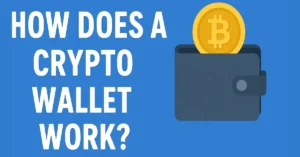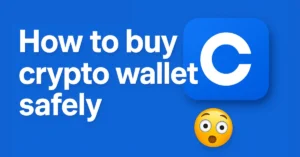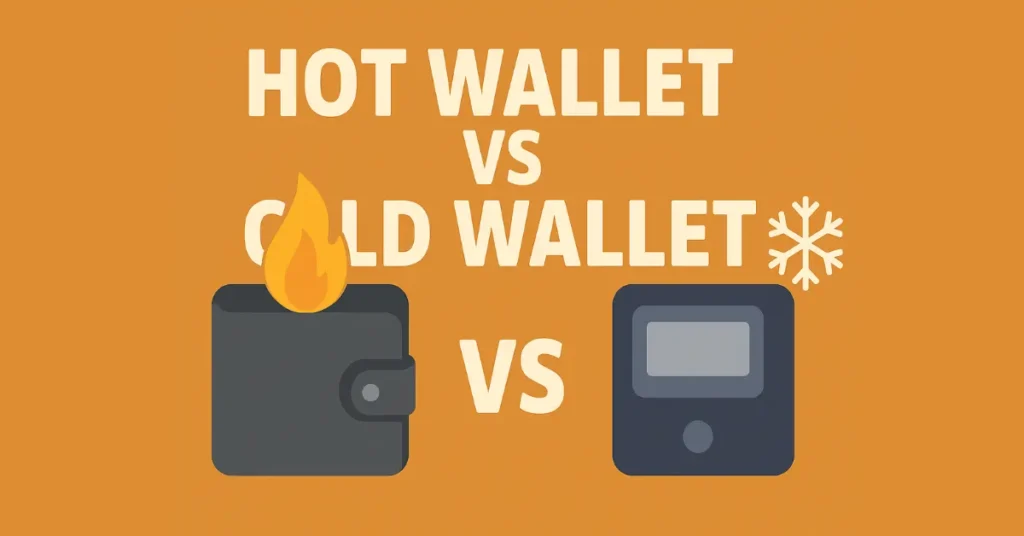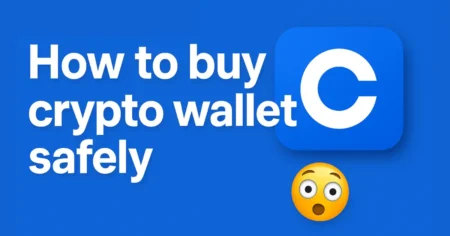Hot Wallet vs Cold Wallet
Introduction
Cryptocurrency has completely changed the way people think about money, ownership, and financial freedom. Instead of relying on banks to store and control our funds, crypto allows us to hold our assets—if we know how to manage them properly. But here’s the thing: owning crypto isn’t as simple as putting dollars in your wallet. You need a crypto wallet, and choosing the right kind can make all the difference between peace of mind and a costly mistake.
That’s where the big question comes in: Should you use a hot wallet or a cold wallet?
This debate has been ongoing for years, and both options have clear advantages and risks. Some people swear by the convenience of hot wallets for quick trades, while others rely on the security of cold wallets for long-term storage. The truth is, the best choice depends on your personal goals, risk tolerance, and how you plan to use your crypto.
In this guide, we’ll break down everything you need to know about hot and cold wallets, from how they work to which one might suit you best. By the end, you’ll have a clear understanding of how to protect your digital assets as safely and smartlyy possible.
Understanding Crypto Wallets
Before diving into hot vs cold wallets, let’s first clear up what a crypto wallet is. A lot of beginners imagine it like a regular wallet that stores coins inside—but that’s not quite accurate.
A crypto wallet doesn’t actually “store” your cryptocurrency. Instead, it stores the keys that give you access to your funds on the blockchain. These keys come in two forms:
- Public Key – Think of this as your bank account number. It’s the address people can use to send you funds.
- Private Key – This is your PIN or password. It proves ownership of the crypto and allows you to spend it. Whoever has the private key controls the crypto.
Now, there’s another important distinction: custodial vs non-custodial wallets.
Custodial wallets are controlled by third parties, like exchanges (Coinbase, Binance, etc.). They hold the private keys on your behalf. This is convenient, but it means you’re trusting someone else with your funds.
Non-custodial wallets give you full control of your private keys. If you lose them, no company can help you recover your funds—but at least you’re not relying on anyone else.
Crypto wallets, whether hot or cold, simply manage how your keys are stored and accessed. Hot wallets are connected to the internet, while cold wallets remain offline. This one difference changes everything in terms of convenience and security.
What is a Hot Wallet?
A hot wallet is any crypto wallet that stays connected to the internet. This connection makes it easy to send and receive funds quickly, which is why many traders and everyday users prefer them.
Common types of hot wallets include:
- Mobile Wallets – Apps like Trust Wallet or MetaMask that let you manage crypto right from your phone.
- Web Wallets – Browser-based wallets like Coinbase Wallet or Binance Wallet that can be accessed through a website.
- Desktop Wallets – Software wallets you install on your computer, like Electrum or Exodus.
Since they’re online, hot wallets are always “ready to go.” You can open the app, log in, and send or receive crypto instantly. That’s why they’re often compared to checking accounts in traditional banking—they’re designed for frequent use rather than long-term storage.
Advantages of Hot Wallets
The biggest advantage of hot wallets is convenience. If you’re an active trader or someone who uses crypto for regular transactions, you’ll appreciate being able to move funds quickly. Imagine you’re out at a coffee shop that accepts Bitcoin—you can pay in seconds with a mobile wallet.
Other key advantages include:
- Accessibility – Since hot wallets are connected to the internet, you can log in from anywhere in the world.
- Ease of Use – Most hot wallets have beginner-friendly interfaces, making them ideal for people just starting out.
- Low Cost – Most hot wallet apps are free to download and use.
- Integration with Exchanges – Many hot wallets connect directly with crypto exchanges, allowing seamless trading.
For short-term use, hot wallets are incredibly practical. They’re the “everyday spending wallet” of the crypto world.
Disadvantages of Hot Wallets
Of course, convenience comes at a cost. Because hot wallets are connected to the internet, they’re much more vulnerable to cyberattacks. Hackers can exploit malware, phishing attempts, or exchange vulnerabilities to steal funds.
Some of the main downsides include:
- Security Risks – Hot wallets are prime targets for hackers, especially if stored on centralized platforms.
- Custodial Risks – If you’re using a custodial hot wallet, you don’t own your keys. Remember the saying: “Not your keys, not your coins.”
- Dependence on Connectivity – No internet means no wallet access. This could be inconvenient during outages.
- Limited Safety for Large Sums – Hot wallets aren’t designed to store massive amounts of crypto safely.
Think of a hot wallet like carrying cash in your pocket—it’s convenient for small purchases but not the best place to keep your life savings.
What is a Cold Wallet?
On the other side of the spectrum, we have cold wallets. These are wallets that remain completely offline, meaning they don’t have an active internet connection. This single feature makes them far more secure against hackers, which is why they’re often compared to a vault or safety deposit box.
Common types of cold wallets include:
- Hardware Wallets – Physical devices like Ledger Nano X or Trezor that store your private keys offline.
- Paper Wallets – A printed version of your private and public keys.
- Air-Gapped Devices – Computers or devices that never connect to the internet, used specifically for storing crypto securely.
Cold wallets are mostly used by long-term investors who don’t need daily access to their funds. If you’ve heard the term HODL (Hold On for Dear Life), cold wallets are where HODLers keep their stash.
Advantages of Cold Wallets
The main advantage of a cold wallet is security. Since they’re offline, hackers can’t access them remotely. This makes them the gold standard for storing large sums of crypto safely.
Other benefits include:
- Strong Protection Against Cyber Threats – No internet means no online vulnerabilities.
- Ideal for Long-Term Storage – Perfect for investors who don’t plan to touch their crypto for years.
- Complete Ownership – With non-custodial hardware wallets, you fully control your private keys.
- Resistant to Exchange Hacks – Even if an exchange gets hacked, your funds in a cold wallet remain safe.
In short, cold wallets are the equivalent of a fireproof safe in your house—they’re not meant for everyday spending, but they’ll protect your wealth for the long haul.
Disadvantages of Cold Wallets
Despite their security benefits, cold wallets aren’t perfect. They trade convenience for safety, which can make them less practical for frequent use.
Some drawbacks include:
- Less Convenient – Every time you want to transfer funds, you need to connect your device or enter keys manually.
- Upfront Cost – Hardware wallets typically cost between $50 to $200.
- Risk of Physical Loss or Damage – If your hardware wallet breaks, gets stolen, or your paper wallet is destroyed, you could lose access permanently.
- Learning Curve – Beginners may find cold wallets intimidating at first, especially when setting up backups.
Think of a cold wallet as burying gold in a vault. It’s extremely safe, but not very practical if you need quick access to funds.
Hot Wallet vs Cold Wallet: Key Differences
Now that we’ve explored both types of wallets individually, let’s put them side by side and see where they really differ. Think of this like comparing a credit card to a safe deposit box—they both store value, but they’re designed for completely different purposes.
Here are the most important differences between hot and cold wallets:
Security
- Hot Wallets: Connected to the internet, which makes them more vulnerable to hacking, phishing, and malware.
- Cold Wallets: Completely offline, which provides maximum protection from online threats.
Convenience
- Hot Wallets: Extremely convenient for frequent transactions. You can send or receive crypto within seconds.
- Cold Wallets: Less convenient since you often need to plug in a device, scan QR codes, or manually sign transactions.
Cost
- Hot Wallets: Usually free (apps or software).
- Cold Wallets: Hardware wallets require a purchase (ranging from $50–$200), while paper wallets are free but less practical.
Best Use Case
- Hot Wallets: Best for active traders, daily spending, or small amounts of crypto.
- Cold Wallets: Best for long-term investors who want to store large amounts securely.
Control
- Hot Wallets: If using a custodial service, you may not fully control your keys.
- Cold Wallets: You have full control, which also means full responsibility.
To sum it up, hot wallets are like a digital checking account—easy access but less security—while cold wallets are like a personal vault—less convenient but extremely safe.
When Should You Use a Hot Wallet?
Hot wallets aren’t bad—they’re just designed for specific purposes. The key is knowing when they make the most sense. If you fall into any of these categories, a hot wallet could be the right choice:
Active Traders
If you buy and sell crypto regularly, speed is everything. Having a hot wallet connected to an exchange or app means you can take advantage of market opportunities instantly. Imagine Bitcoin suddenly drops, and you want to buy more—you’ll be able to move funds quickly without digging out a hardware wallet.
Small to Medium Holdings
For smaller amounts of crypto—let’s say less than what you’d be comfortable carrying in your regular wallet—a hot wallet is fine. Think of it like having some spending money on hand while keeping your savings locked away in a bank.
Quick Transfers and Payments
Hot wallets are ideal for making payments, especially as more businesses start accepting cryptocurrency. If you’re paying for goods, sending money to friends, or experimenting with decentralized apps (dApps), hot wallets are your best bet.
Learning and Experimentation
If you’re new to crypto, starting with a hot wallet is easier. It’s less intimidating than setting up a hardware device, and most apps provide built-in tutorials. Once you get comfortable, you can graduate to a cold wallet for bigger investments.
Tip: If you’re going to use a hot wallet, make sure you enable two-factor authentication (2FA), keep your device updated, and avoid storing large amounts of crypto.
When Should You Use a Cold Wallet?
Cold wallets are the opposite—they’re not meant for daily use but for safe, long-term storage. If any of these situations apply to you, then a cold wallet is essential:
Long-Term Investors (HODLers)
If your strategy is to buy crypto and hold it for years, there’s no reason to keep it online. A cold wallet will keep your funds safe from hacks, allowing you to sleep better at night knowing your assets aren’t exposed.
Large Sums of Crypto
The bigger your holdings, the more sense it makes to invest in a cold wallet. For example, if you’re storing thousands of dollars in Bitcoin or Ethereum, the cost of a $100 hardware wallet is nothing compared to the protection it provides.
Institutions and Businesses
Companies or organizations that manage crypto on behalf of clients usually rely on cold storage solutions. Many even use multi-signature cold wallets, where multiple approvals are required before funds can be moved.
Security-Focused Users
If you’re particularly cautious—or if you’ve already had a bad experience with hacks—you’ll probably feel safer using a cold wallet exclusively. Even if it takes extra steps to transfer funds, the security trade-off is worth it.
Tip: Always create a backup of your seed phrase and store it in a secure place (like a fireproof safe). Losing access to your cold wallet without a backup can mean losing your crypto forever.
Combining Hot and Cold Wallets: The Hybrid Approach
Here’s a little secret: you don’t actually have to choose just one. Many experienced investors use both hot and cold wallets to get the best of both worlds.
This hybrid approach works like this:
- Keep a small portion of funds in a hot wallet for trading, payments, and dApps.
- Store the majority of your crypto in a cold wallet for security and long-term holding.
It’s similar to how people manage traditional money. You wouldn’t keep all your savings in cash in your pocket, right? Instead, you carry just enough for everyday expenses while keeping the rest in a safe place.
Example Strategy
- 10% of funds in a hot wallet for quick access
- 90% of funds are in a cold wallet for long-term storage
This way, even if your hot wallet is compromised, you’re only risking a small amount of your total holdings.
Some advanced users also create multiple wallets for different purposes—for example, one cold wallet for Bitcoin, another for Ethereum, and a hot wallet for daily trading. It all depends on your comfort level and goals.
Pro Tip: Always test small transactions first when moving between hot and cold wallets. Sending $10 as a test can prevent costly mistakes when you later transfer larger amounts.
Security Best Practices for Crypto Wallets
Whether you choose a hot wallet, a cold wallet, or both, security should always be your top priority. The crypto world is full of opportunities, but it’s also full of scammers, hackers, and bad actors waiting for mistakes.
Here are some best practices to keep your wallets safe:
Protect Your Private Keys
Never share your private keys with anyone. If someone has them, they can drain your wallet instantly.
Use Strong Passwords
If your wallet allows for password protection, don’t reuse passwords from other accounts. Use a strong combination of letters, numbers, and symbols.
Enable Two-Factor Authentication (2FA)
Always add 2FA for an extra layer of protection, especially with hot wallets.
Keep Your Seed Phrase Offline
Your recovery phrase (seed phrase) is the master key to your wallet. Write it down and store it in a safe, offline location. Avoid saving it on your computer or phone.
Watch Out for Phishing Scams
Hackers often impersonate wallet providers or exchanges. Always double-check website URLs before entering login details.
Update Software and Firmware
For both hot wallets and hardware wallets, make sure you’re running the latest versions. Updates often include important security patches.
Diversify Storage
Don’t keep all your crypto in one wallet. Spread it out across multiple wallets if you’re holding a significant amount.
By following these steps, you’ll reduce the chances of losing your hard-earned crypto to theft or mistakes.
Hot Wallet vs Cold Wallet: Which is Better for Beginners?
If you’re new to crypto, one of the hardest choices you’ll face is deciding between a hot or cold wallet. The truth is, both can be suitable, but beginners usually lean toward hot wallets for one simple reason: ease of use.
Hot wallets are designed to be straightforward. Download an app, write down your recovery phrase, and you’re ready to go. For someone still learning the ropes, this accessibility makes it less intimidating. You also don’t have to spend extra money on hardware right away, which is a big plus if you’re just experimenting with small amounts.
However, there’s a catch. Beginners are also the most vulnerable to scams and mistakes. Hackers know that newcomers often store everything in hot wallets without proper security. That’s why, if you’re starting out, I suggest this approach:
- Start with a Hot Wallet – Keep only a small amount of crypto while you’re learning. This allows you to practice without risking much.
- Graduate to a Cold Wallet – Once you’ve invested a larger amount or you’re confident about long-term holding, invest in a hardware wallet.
- Mix Both if Needed – Use a hot wallet for play money and transactions, while keeping your serious holdings in cold storage.
Pro Insight: If I were teaching a complete beginner, I’d recommend starting with a non-custodial hot wallet (like Trust Wallet or MetaMask). This way, they get used to managing their own private keys, rather than leaving everything in an exchange account. From there, moving to a hardware wallet becomes a natural next step.
Real-World Scenarios and Examples
Sometimes it helps to see how different types of people use wallets in real life. Let’s look at a few scenarios.
The Active Trader
Alex trades cryptocurrencies daily. He watches the market like a hawk and needs instant access to his funds to take advantage of price swings. For him, a hot wallet connected to an exchange makes perfect sense. He keeps small amounts there for quick trades but transfers profits to a cold wallet at the end of each week for safety.
The Long-Term Investor
Sarah bought Bitcoin back in 2017 and has no plans to sell anytime soon. She believes in the long-term growth of crypto, so she stores her coins in a hardware wallet. This way, she doesn’t worry about exchange hacks or malware. Her cold wallet sits safely in a fireproof safe, and she checks it only once in a while.
The Small Business Owner
David runs a coffee shop that accepts cryptocurrency payments. He uses a hot wallet on his tablet to receive payments from customers quickly. However, at the end of every month, he transfers the accumulated funds into a cold wallet for safekeeping. This hybrid approach allows him to run his business efficiently without putting too much at risk.
The Crypto Enthusiast
Emily loves experimenting with decentralized finance (DeFi) apps and NFTs. She keeps a small amount of Ethereum in her hot wallet to interact with smart contracts daily. But she’s also cautious—her valuable NFTs and larger holdings stay in a hardware wallet.
These examples highlight one important truth: there is no one-size-fits-all solution. The right wallet depends on your lifestyle, goals, and tolerance for risk.
Expert Insights and Tips
Over the years, I’ve seen countless stories of people losing their crypto—not because they invested in the wrong coin, but because they failed to secure their wallets. That’s why, beyond choosing hot vs cold, I recommend a few additional strategies:
Treat Your Seed Phrase Like Gold
Your recovery phrase is the single most important piece of information in crypto. If you lose it, you lose access forever. I personally suggest writing it down on paper and storing it in two different secure places. Some people even engrave it on metal plates for durability against fire and water damage.
Never Leave Large Amounts on Exchanges
Exchanges are convenient, but they’re also prime targets for hackers. Even the biggest platforms aren’t immune. History has shown that “trusted” exchanges can get hacked or freeze withdrawals. Always move your funds to your wallet after trading.
Consider Multi-Signature Wallets
For those with larger holdings, multi-signature wallets add an extra layer of security. They require multiple approvals before a transaction goes through, which makes it much harder for hackers to steal your funds.
Stay Updated on Wallet Technology
Crypto wallets continue to evolve. For example, some new wallets now offer biometric security, encrypted backups, or integration with decentralized apps. Staying informed can help you make smarter decisions.
Don’t Put All Your Eggs in One Basket
Diversify not only your crypto investments but also your wallet usage. Splitting funds between multiple wallets reduces the risk of losing everything to a single point of failure.
From my own perspective, the smartest strategy is always balance. Convenience matters—you don’t want to lock yourself out of your funds—but security is non-negotiable. Treat your crypto with the same seriousness as you would treat your life savings.
Conclusion
So, hot wallet vs cold wallet—which one should you choose? The answer is: it depends on your needs.
If you’re actively trading, experimenting with dApps, or making frequent payments, a hot wallet is your best friend. It’s quick, easy, and convenient.
If you’re holding large sums or planning to invest long-term, a cold wallet is essential. It keeps your assets safe from online threats.
And if you want the best of both worlds, the hybrid approach—using both hot and cold wallets—is the smartest choice.
At the end of the day, the type of wallet you use reflects your personal crypto journey. But no matter which path you take, one rule remains constant: always prioritize security. The crypto space is filled with opportunities, but also risks. Protect your investments today, so you can enjoy the rewards tomorrow.
FAQs
Can you lose crypto stored in a hot wallet?
Yes. If your hot wallet is hacked, compromised by malware, or you fall for a phishing scam, your funds can be stolen. That’s why it’s best to only keep small amounts in hot wallets.
What happens if you lose your cold wallet device?
If you have your recovery phrase backed up, you can restore access to your funds on a new device. Without the recovery phrase, the crypto is lost forever.
Are hardware wallets worth the investment?
Absolutely. If you hold a significant amount of crypto, the cost of a hardware wallet ($50–$200) is a small price for peace of mind and top-notch security.
Is it safe to keep all your crypto in one wallet?
It’s not recommended. Spreading your crypto across multiple wallets reduces the risk of losing everything if one wallet is compromised.
Which wallet type is best for beginners?
Hot wallets are easier for beginners to start with, but it’s best to transition to a cold wallet once your holdings grow. A hybrid approach works best for most people.
Also, read
- What is a crypto wallet, and how does it work? – Coinsify
- 10 Crypto Terms Every Beginner Must Know: Coinsify
- What is blockchain technology? Complete Guide – Coinsify
- How to Buy Crypto Safely in 2025: Complete Guide – Coinsify
- Bitcoin vs Ethereum: Key Differences Explained: Complete Guide
- Ultimate Blockchain Glossary: Learn Blockchain Terms Easily
- How to Buy Bitcoin Safely (Complete Beginner’s Guide)
- Top 10 Crypto Wallets for Beginners (2025 Edition)
- What is cryptocurrency? A Beginner-Friendly Guide (2025)






